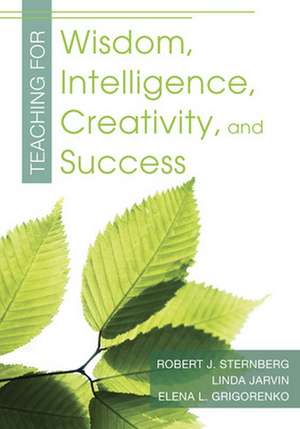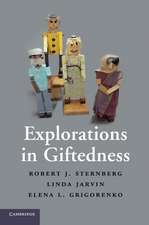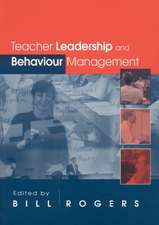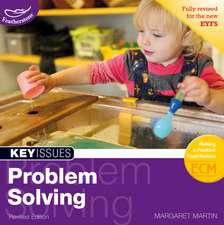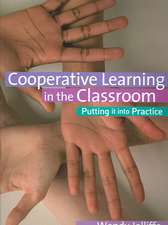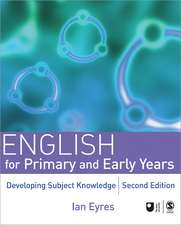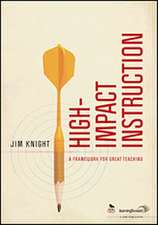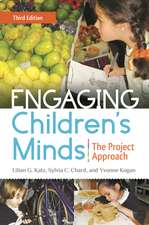Teaching for Wisdom, Intelligence, Creativity, and Success
Editat de Robert J. Sternberg, Linda Jarvin, Elena L. Grigorenkoen Limba Engleză Paperback – 22 mar 2009
Louisiana State University
The essential guide for teaching beyond the test!
Students with strong higher-order thinking skills are more likely to become successful, lifelong learners. Based on extensive, collaborative research by leading authorities in the field, this book shows how to implement teaching and learning strategies that nurture intelligence, creativity, and wisdom.
This practical teaching manual offers an overview of the WICS model—Wisdom, Intelligence, Creativity, Synthesized—which helps teachers foster students' capacities for effective learning and problem solving. Teachers will find examples for language arts, history, mathematics, and science in Grades K–12, as well as:
- Hands-on strategies for enhancing students' memory, analytical, creative, and practical skills
- Guidelines on teaching and assessing for successful intelligence
- Details on how to apply the model in the classroom
- Teacher reflection sections, suggested readings, and sample planning checklists
Teaching for Wisdom, Intelligence, Creativity, and Success is ideal for educators seeking to broaden their teaching repertoire as they expand the skills and abilities of students at all levels.
Preț: 282.83 lei
Nou
Puncte Express: 424
Preț estimativ în valută:
54.13€ • 58.77$ • 45.47£
54.13€ • 58.77$ • 45.47£
Carte tipărită la comandă
Livrare economică 22 aprilie-06 mai
Preluare comenzi: 021 569.72.76
Specificații
ISBN-13: 9781412964531
ISBN-10: 1412964539
Pagini: 192
Ilustrații: black & white tables, figures
Dimensiuni: 178 x 254 x 12 mm
Greutate: 0.41 kg
Ediția:1
Editura: SAGE Publications
Colecția Corwin
Locul publicării:Thousand Oaks, United States
ISBN-10: 1412964539
Pagini: 192
Ilustrații: black & white tables, figures
Dimensiuni: 178 x 254 x 12 mm
Greutate: 0.41 kg
Ediția:1
Editura: SAGE Publications
Colecția Corwin
Locul publicării:Thousand Oaks, United States
Recenzii
"Interesting insights into the planning of teaching strategies with some fresh new ideas. Takes Tyler, Taba, Eisner, and Joyce to a new level."
"Offers explicitly practical strategies for fine-tuning and balancing instruction and assessment. The strategies help assess wise thinking skills and creative thinking skills and match assessment of achievement to broad teaching."
"The variety and quantity of practical examples can be quickly converted to classroom use."
"This book encourages teachers to go beyond traditional instruction designed for narrow kinds of thinking and testing."
"Offers a great opportunity for teachers to reflect on their practice in a constructive way. The book serves well as a schoolwide professional development initiative in learning communities and offers opportunities for teachers to tweak their instruction for better understanding and meaningful learning."
"This is a blockbuster of a book. It allows teachers to follow standards, but provides space for them to develop students' wisdom, intelligence, and creativity (and of course success). Teachers will be free to teach without being limited to textbook formats. Both teachers and students will come to understand themselves and their values better."
"This book presents a model to help teachers teach content while teaching important skills that make the content meaningful. The authors explain and give examples of how to apply their model and explicitly make connections to assessment and state standards. Using this model will enrich the education of students and fill the enormous gap created by high-stakes tests and the accountability movement."
"Offers explicitly practical strategies for fine-tuning and balancing instruction and assessment. The strategies help assess wise thinking skills and creative thinking skills and match assessment of achievement to broad teaching."
"The variety and quantity of practical examples can be quickly converted to classroom use."
"This book encourages teachers to go beyond traditional instruction designed for narrow kinds of thinking and testing."
"Offers a great opportunity for teachers to reflect on their practice in a constructive way. The book serves well as a schoolwide professional development initiative in learning communities and offers opportunities for teachers to tweak their instruction for better understanding and meaningful learning."
"This is a blockbuster of a book. It allows teachers to follow standards, but provides space for them to develop students' wisdom, intelligence, and creativity (and of course success). Teachers will be free to teach without being limited to textbook formats. Both teachers and students will come to understand themselves and their values better."
"This book presents a model to help teachers teach content while teaching important skills that make the content meaningful. The authors explain and give examples of how to apply their model and explicitly make connections to assessment and state standards. Using this model will enrich the education of students and fill the enormous gap created by high-stakes tests and the accountability movement."
Cuprins
List of Tables
About This Book
Acknowledgments
About the Authors
Section I. Teaching for Wisdom, Intelligence, and Creativity
1. Introduction to Teaching for Wisdom, Intelligence, and Creativity
2. What Is the WICS Model?
3. Your Turn: What Is Your Pattern of Strengths?
Section II. Why and How to Teach for Successful Intelligence
4. Introduction to Teaching for Successful Intelligence
5. How to Enhance Memory Skills
6. How to Enhance Analytical Skills
7. How to Enhance Creative Skills
8. How to Enhance Practical Skills
9. Your Turn: Identify Different Types of Teaching Strategies
Section III. Integrating Teaching and Assessment in Your Classroom
10. Introduction to Integrating Teaching and Assessment
11. Matching Assessment and Instruction
12. General Guidelines for Developing Diversified Assessments
13. Assessing and Rating Memory Skills
14. Assessing and Rating Analytical Skills
15. Assessing and Rating Creative Skills
16. Assessing and Rating Practical Skills
17. Your Turn: Develop Different Types of Assessment Questions
Section IV. Why and How to Teach for Wisdom
18. Introduction to Teaching for Wisdom
19. Three Wisdom-Based Thinking Skills
20. Six General Guidelines for Teaching for Wisdom
21. Reflection: How Can You Promote Wise Thinking in Your Classroom?
Section V. Synthesis: Helping Students Achieve Success and Satisfaction in Their Lives
22. Introduction to Achieving Balance
23. How to Balance It All
24. A Word of Wisdom on Learning Goals
25. Wisdom, Intelligence, and Creativity, Synthesized
Answer Keys
Appendix to Section I: Suggested Further Readings for Those Who Want to Learn More About the WICS Model and Other Resources on Teaching Strategies
Appendix to Section II: Mnemonic Techniques and Strategies
Appendix to Section III: Cross-Reference of Sample Tables by Grade, Level, Content Area, Response Format, and Cognitive Skill Assessed
References
Index
About This Book
Acknowledgments
About the Authors
Section I. Teaching for Wisdom, Intelligence, and Creativity
1. Introduction to Teaching for Wisdom, Intelligence, and Creativity
2. What Is the WICS Model?
3. Your Turn: What Is Your Pattern of Strengths?
Section II. Why and How to Teach for Successful Intelligence
4. Introduction to Teaching for Successful Intelligence
5. How to Enhance Memory Skills
6. How to Enhance Analytical Skills
7. How to Enhance Creative Skills
8. How to Enhance Practical Skills
9. Your Turn: Identify Different Types of Teaching Strategies
Section III. Integrating Teaching and Assessment in Your Classroom
10. Introduction to Integrating Teaching and Assessment
11. Matching Assessment and Instruction
12. General Guidelines for Developing Diversified Assessments
13. Assessing and Rating Memory Skills
14. Assessing and Rating Analytical Skills
15. Assessing and Rating Creative Skills
16. Assessing and Rating Practical Skills
17. Your Turn: Develop Different Types of Assessment Questions
Section IV. Why and How to Teach for Wisdom
18. Introduction to Teaching for Wisdom
19. Three Wisdom-Based Thinking Skills
20. Six General Guidelines for Teaching for Wisdom
21. Reflection: How Can You Promote Wise Thinking in Your Classroom?
Section V. Synthesis: Helping Students Achieve Success and Satisfaction in Their Lives
22. Introduction to Achieving Balance
23. How to Balance It All
24. A Word of Wisdom on Learning Goals
25. Wisdom, Intelligence, and Creativity, Synthesized
Answer Keys
Appendix to Section I: Suggested Further Readings for Those Who Want to Learn More About the WICS Model and Other Resources on Teaching Strategies
Appendix to Section II: Mnemonic Techniques and Strategies
Appendix to Section III: Cross-Reference of Sample Tables by Grade, Level, Content Area, Response Format, and Cognitive Skill Assessed
References
Index
Descriere
Based on an extensive research, this practical teaching resource provides instructional and assessment guidelines for strengthening students' higher-order thinking and reasoning skills.
